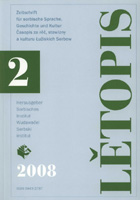Das sorbische Osterreiten in der Oberlausitz. Soziologische Reflexionen
The Easter Procession of the Sorbs in Upper Lusatia. Sociological Reflexions
Author(s): Marén SchorchSubject(s): Cultural Essay, Political Essay, Societal Essay
Published by: Domowina-Verlag GmbH / Ludowe nakładnistwo Domowina
Keywords: easter procession; sorbs; upper lusatia
Summary/Abstract: Rituals are omnipresent in life, especially in the context of religion. Their function on the one hand (amongst others) is to mark changes in individual and family life cycle transitions (e.g. communion or marriage). On the other hand, they facilitate the transmission of values and beliefs, emotions etc., an image of continuity of a certain community through time and socio-economical changes. They especially help communities to assure themselves of their collective identity – also by implicitly defining the borders to others, non-members. The ethnic minority of the Sorbs in south-eastern Germany is one example of such a collective identity. The Catholic Sorbs in Saxony, in particular, are faced with a double Abstracts 155 minority situation: As an autochthonous minority they cannot refer to a nation state (in contrast to national minorities such as Turkish migrants), but live in an enclave in a more or less German and Protestant (or even atheist) environment. This article focuses on that special constellation by analysing one of the major religious rituals of the Catholic Sorbs: the Easter procession in Upper Lusatia. Annually, on Easter Sunday, nine processions of approximately 1,700 smartly dressed male Sorbs on horses celebrate a ritual similar to a full-time church service, announcing the resurrection of Jesus Christ. But most remarkably, lay groups are the organizers and protagonists of the procession, not the Church (even if church services provide the structure for the ritual). This analysis describes the ritual in detail and discusses its meaning for the Sorbian community. The continuity of the procession and its procedures over several centuries symbolize one central characteristic of the ritual (here described as a traditional anchor within a complex, globalized world). This is underlined by the fact that there is a recognisable increase in the number of participants (mainly young Sorbs) over the last two decades. Therefore, the article closes with a discussion about re-ethnicity in the context of the Easter procession of the Sorbs.
- Issue Year: 2008
- Issue No: 2
- Page Range: 42-60
- Page Count: 19
- Language: German
- Content File-PDF

